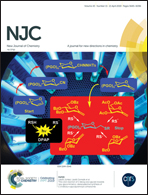Doping MoS2 monolayer with nonmetal atoms to tune its electronic and magnetic properties, and chemical activity: a computational study†
Abstract
Introducing heteroatoms into two-dimensional nanosheets was revealed to be a quite promising strategy to tune their electronic and magnetic properties as well as chemical reactivity, thus greatly widening their application fields. Herein, by means of density functional theory (DFT) computations, we have systematically investigated the electronic and magnetic properties as well as chemical reactivity of MoS2 nanosheets doped with several common nonmetal dopants (B, C, N, O, and P). Our results revealed that these nonmetal atoms can be strongly captured by the S vacancy of the MoS2 nanosheet, ensuring their high stability. Compared with the pristine MoS2 nanosheet, these doped MoS2 systems exhibit decreased band gaps due to the introduction of impurity levels. In particular, the adsorption of gas molecules on the MoS2 monolayer can be enhanced to different degrees after nonmetal doping, suggesting great potential for developing gas sensors or catalysts. Thus, by carefully choosing the nonmetal atoms, the inert basal plane of a MoS2 nanosheet can be effectively activated for various applications.



 Please wait while we load your content...
Please wait while we load your content...